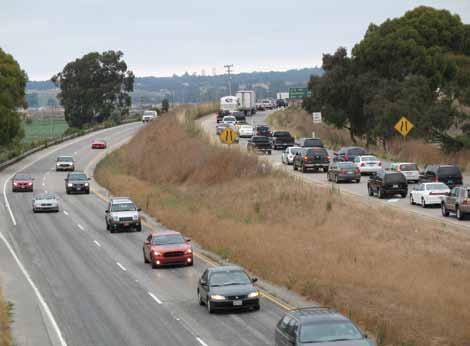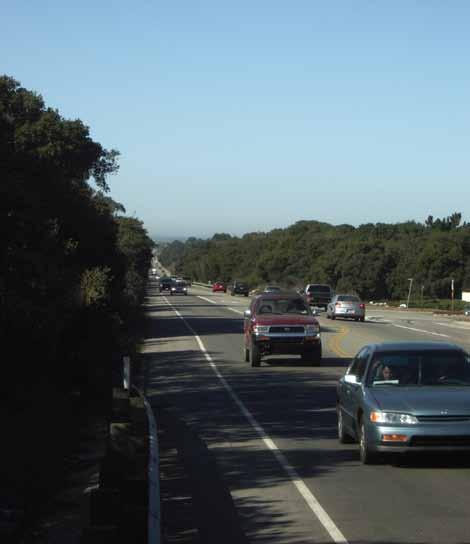
8 minute read
Testing your INVEST-ment in highway sustainability
Monterey Bay project gets the gold
Debbie Hale, Executive Director, Transportation Agency for Monterey County, California, and Chair, APWA Transportation Committee; Lisa Reid, P.E., PMP, Senior Sustainability Consultant, CH2M Hill, Bellevue, Washington, and member, APWA Transportation Sustainability Subcommittee
Advertisement
he Monterey Bay is known for its interest in preserving the environment, an environment that draws over eight million visitors a year to this scenic destination. As planners with the Transportation Agency for Monterey County, we are sensitive to the notion that our projects should be as sustainable as possible. We want to honor the three “e”s of sustainability by balancing the equity concerns for our residents, the impacts to our natural environment, and the needs of our $2.5 billion per year tourism economy. But how can a highway project be sustainable? That is where sustainability rating systems come into play. When we heard that the Federal Highway Administration was planning a pilot test of its new INVEST (Infrastructure Voluntary Evaluation Sustainability Tool) sustainable self-evaluation system for highways, we were eager to sign up. Our State Route 156 west widening and interchange project became one of just two projects in California, and 17 projects nationwide, to participate in testing of the Pilot Test Version of the Project Development module of INVEST.
INVEST identifies the characteristics of sustainable highway development via a web-based self-evaluation tool. The tool is intended to provide a method for practitioners to evaluate their transportation projects and to encourage progress in the sustainability arena. It is not required in order to receive federal funding and it is not intended to result in comparisons across transportation agencies and projects, but it is intended to encourage project managers to learn how to make their projects more sustainable, according to a set of 29 criteria that assign points to specific sustainability best practices (see chart for Version 1 criteria). Projects can reach four different achievement levels of sustainability: bronze, silver, gold and platinum. We evaluated the Project Development module, but there are also System Planning and Operations & Maintenance modules that cover the rest of the project life cycle. The Pilot Test Version of the Project Development module had basic and extended scorecards that filtered applicable criteria depending on the type of project being evaluated.
The INVEST web-based tool was a good fit for our project and our team. As a small agency in a mediumsized county (425,000 people), it would be difficult to participate in a sustainability analysis that would be costly or time-consuming. Our State Route 156 project will improve safety and mobility by creating a new four-mile, four-lane highway segment, converting the existing highway to a frontage road, replacing an existing traffic signal with an interchange, and rebuilding the highway to highway connection. The project had just completed the state and federal environmental review process, so a great deal of
Traffic on eastbound Highway 156 as it narrows from two lanes to one lane.
information was available. We were early enough in the process to be able to learn from a sustainability analysis and make incremental changes. We also had a collaborative team that was made up of local and state Department of Transportation (Caltrans) staff who could easily be assembled to participate in the pilot program.
FHWA had a very supportive six-step process for its pilot test—one that we would encourage them to utilize to guide users in their future use of the tool. First, we assembled our team, all of whom attended FHWA’s orientation webinar on the features of the website and the evaluation process. Our team, led by our project manager, Mike Zeller, included our agency’s engineer and executive managers, as well the Caltrans project manager, environmental manager, and lead designers. We felt that the participation of our executive managers was critical to making any sustainability improvements that would be suggested in the evaluation process.
After the orientation, our project manager navigated the website, reviewed the scoring criteria, and asked for clarifications when needed. At this point, he also made an initial assessment of where the project was likely to meet the criteria and where more information would be needed. He then developed a list of the data required to complete the scoring evaluation. He assigned team members to collect the relevant data, so that the information would be available for scoring at the evaluation workshop. After gathering the information, the Scoring Team members evaluated the criteria in each of their assigned research areas and took a first cut at determining if the project met or did not meet the scoring requirements. Next, we held the scoring workshop. The workshop was facilitated by Lisa Reid, CH2M Hill, the lead consultant for the INVEST tool development and testing. All team members attended the workshop. This workshop was where the real evaluation of the project and the INVEST tool took place. We spent three hours working through all the criteria, answering each of the questions, clarifying the explanation, understanding the project features, and making suggestions for improving the INVEST criteria and tool. Our team worked hard to give our project a high, yet accurate, sustainability rating. The consultant recorded our comments, answered our questions, and indicated where other pilot testers and reviewers had agreed that changes were needed.
The self-evaluation is finalized with a scorecard that summarizes your score by criterion and provides feedback on how many points are needed to reach the next level. What level did our project achieve? We reached the “gold” level of 64 points, just seven points away from platinum. Our project scored well in terms of cost-benefit, mobility, and safety improvements, which makes sense since its purpose is to increase capacity and improve safety, at the lowest cost possible. We also learned that, due to a number of best practices by Caltrans, the project also does a good job of protecting the environment— including environmental tracking, habitat preservation and restoration, stormwater management, and ecological connectivity. We reviewed the areas where our scores were low and agreed to look into making improvements in the areas of public education about sustainability features, energy-efficient lighting, reduced pavement emissions, contractor warranty, and construction quality control planning. With sustainable improvements in these areas, we plan to achieve a platinum level scoring on our final project.
INVEST, Version 1 INVEST, Version 1
PROJECT DEVELOPMENT CRITERIA
PD-1 Economic Analysis PD-2 Life-Cycle Cost Analyses PD-3 Context Sensitive Project Development PD-4 Highway and Traffic Safety PD-5 Educational Outreach PD-6 Tracking Environmental Commitments PD-7 Habitat Restoration PD-8 Stormwater PD-9 Ecological Connectivity PD-10 Pedestrian Access PD-11 Bicycle Access PD-12 Transit & HOV Access PD-13 Freight Mobility PD-14 ITS for System Operations PD-15 Historical, Archaeological, and Cultural Preservation PD-16 Scenic, Natural, or Recreational Qualities PD-17 Energy Efficiency PD-18 Site Vegetation PD-19 Reduce and Reuse Materials PD-20 Recycle Materials PD-21 Earthwork Balance PD-22 Long-Life Pavement Design PD-23 Reduced Energy and Emissions in Pavement Materials PD-24 Contractor Warranty PD-25 Construction Environmental Training PD-26 Construction Equipment Emissions Reduction PD-27 Construction Noise Mitigation PD-28 Construction Quality Control Plan PD-29 Construction Waste Management
PROJECT DEVELOPMENT CRITERIA PD-1 Economic Analysis PD-2 Life-Cycle Cost Analyses PD-3 Context Sensitive Project Development PD-4 Highway and Traffic Safety PD-5 Educational Outreach PD-6 Tracking Environmental Commitments PD-7 Habitat Restoration PD-8 Stormwater PD-9 Ecological Connectivity PD-10 Pedestrian Access PD-11 Bicycle Access PD-12 Transit & HOV Access PD-13 Freight Mobility PD-14 ITS for System Operations PD-15 Historical, Archaeological, and Cultural Preservation PD-16 Scenic, Natural, or Recreational Qualities PD-17 Energy Efficiency PD-18 Site Vegetation PD-19 Reduce and Reuse Materials PD-20 Recycle Materials PD-21 Earthwork Balance PD-22 Long-Life Pavement Design PD-23 Reduced Energy and Emissions in Pavement Materials PD-24 Contractor Warranty PD-25 Construction Environmental Training PD-26 Construction Equipment Emissions Reduction PD-27 Construction Noise Mitigation PD-28 Construction Quality Control Plan PD-29 Construction Waste Management
Our project manager then provided a written memo giving feedback on how the tool worked and how it could better help us meet our sustainability goals. The final step was a national webinar at which the FHWA team summarized the suggestions from all the pilot studies around the country. How well did the tool score? Overall, we would rate the website as easy to use, but needing greater flexibility and clarity. We’re pleased that FHWA has incorporated changes that address most of our comments and are looking forward to using the official version of the tool on our projects.
To address comments made in the pilot testing process, FHWA has made many improvements to Version 1 of INVEST, which is being launched. Some of the key changes made include:
• Revised Project Development
Scorecards to be based on type of project, as well as the location (urban vs. rural) • Addition of a custom scorecard for users who would like to choose their own criteria
• More detailed explanations of what is required to obtain scores within the criteria
• More “partial credit” rather than
“all or nothing” scores • Ability to record scoring notes and next actions, and to upload supporting documents for future reference
• Ability to collaborate on scoring with multiple people accessing same project • Option to save a scoring
“snapshot” to record scenarios or progression of scoring over time • Opportunities for users to improve the tool over time FHWA’s goal for the pilot testing process was to improve the accuracy and usability of their web-based sustainability rating tool. Our goal was to learn about and improve the sustainability of our project. I would say that both agencies earned a “gold” medal in their efforts, and with future improvements can move up the podium to “platinum.”
The new and improved INVEST Version 1 is being rolled out and can be found at www. sustainablehighways.org. Keep your eye out for APWA announcements of FHWA’s upcoming instructional webinars.

Heritage oaks lining the corridor will be preserved under the new four-lane highway alignment.
Debbie Hale is the Executive Director of the Transportation Agency for Monterey County, California, a regional agency that plans, funds, and delivers all modes of transportation projects. She currently serves as the chair of the APWA Transportation Committee. She can be reached at debbie@ tamcmonterey.org or (831) 775-4410.
Lisa Reid, P.E., PMP, is a Senior Program Manager and Sustainability Consultant with CH2M Hill, and is a member of APWA’s Transportation Sustainability Subcommittee. She can be reached at Lisa.Reid@ch2m.com or (425) 233-3143.







